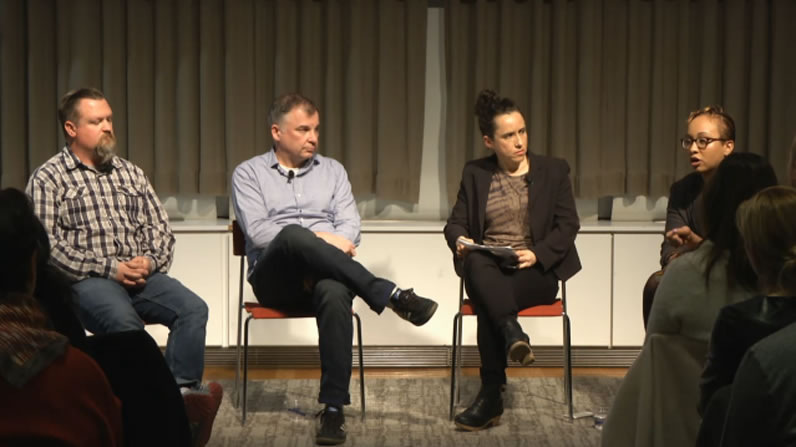
News Products of the Future: Journalism + Design Leads Critical Conversation
“If you’re a professional in the journalism world, raise your hand.”
When Heather Chaplin, chair of the Journalism + Design program at The New School, addressed this question to the overflow Theresa Lang Center audience last week, most of the hands in the room went up.
“Now,” she continued, “if you’re still seeking clarification on what all this ‘new product’ talk is all about, raise your hand.”
Again most of the hands in the room went up.
For Chaplin, the result of this snap poll was telling: Many people are still pursuing careers in journalism, but few are privy to the complicated and ever-evolving suite of original, cutting-edge being produced by digital news organizations.
Chaplin and a panel of news product managers filled in the blanks during “The Hunt for News Products of the Future,” a discussion featuring Aron Pilhofer, interim chief digital officer at The Guardian; Trei Brundrett, chief product officer at Vox Media; Stacy-Marie Ishmael, managing editor for mobile news at BuzzFeed; and Chaplin, who served as moderator.
Co-hosted by Journalism + Design and the Tow-Knight Center for Entrepreneurial Journalism at the City University of New York, the wide-ranging discussion revolved around the products that have emerged amid journalism’s migration from the print to the digital realm, how they are being employed by news product managers to tell engaging stories, and the ways they may shape the future of the journalism industry.
As Buzzfeed’s managing editor for mobile news, Ishmael has made it her job to design and develop digital news products that disseminate Buzzfeed’s viral content in a way that “goes farther, is better, and has a better shot at reaching the audiences to whom it is relevant,” she said.
In the last two years, Ishmael and her team have designed apps for mobile users, rendered displays for social media browsers, and designed “instant articles” for Facebook feeds.
“The way that I’ve been thinking about this is: What are all the things that are not the story that make the story possible?” she said.
A longtime interactive news editor for the New York Times who stepped into his current role at The Guardian two years ago, Pilhofer hopes there will soon be a day when digital news products don’t just make the story, but also “become the story.” As it stands, he said, “The newsroom sits as this obelisk in the middle of the organization and people just kind of circle around it.”
“Traditionally, the product has tended to be everything but the story, and I think for a long time that was probably OK,” Pilhofer continued. “But I don’t think it’s going to be OK for very much longer.”
At some point, he added, those products will “dictate what kinds of stories are told.”
Asked for his opinion on the best digital news products on the market, Brundrett pointed to the new mobile app form Quartz, a digital-only business news publication. The app, which was released earlier this year, is designed with a “messaging bot”—a text message interface that sends news alerts and with which users can interact.
“It’s playing with the idea of the product as service,” Brundrett said. “I think some of the most interesting products right now are ones that decouple us from the notion of what the news product is and engage us in a personal way.”
Although digital news products open up numerous storytelling possibilities, concerns around their monetization linger. As Lux Alptraum, co-director of the nonprofit organization Out of the Binders, put it during a Q&A session, “How are news organizations going to be able to make money with all of this awesome stuff?”
Pilhofer acknowledged that news organizations haven’t quite figured that out. For the last two decades news organizations have faced a growing cash-flow problem rooted in dramatically declining advertising revenues; his publication, The Guardian, is set to lose £80 million this year. Still, Pilhofer stressed, “you can’t cut your way to profitability.”
“The only way out is developing new revenue lines or enhancing the ones you already have,” he said. “The strategy we came up with is fundamentally going back to readers” and asking them to pay a premium for select services and content—many of which are delivered through the digital news products they create.
The message from the panelists was clear: To survive in the digital age, news organizations and emerging journalism professionals will have to reallocate resources and expertise into designing products that can tell stories in engaging ways. Students in the Journalism + Design, a program that teaches the skills needed to address the complex media ecosystem of the 21st century, will learn how to do just that.